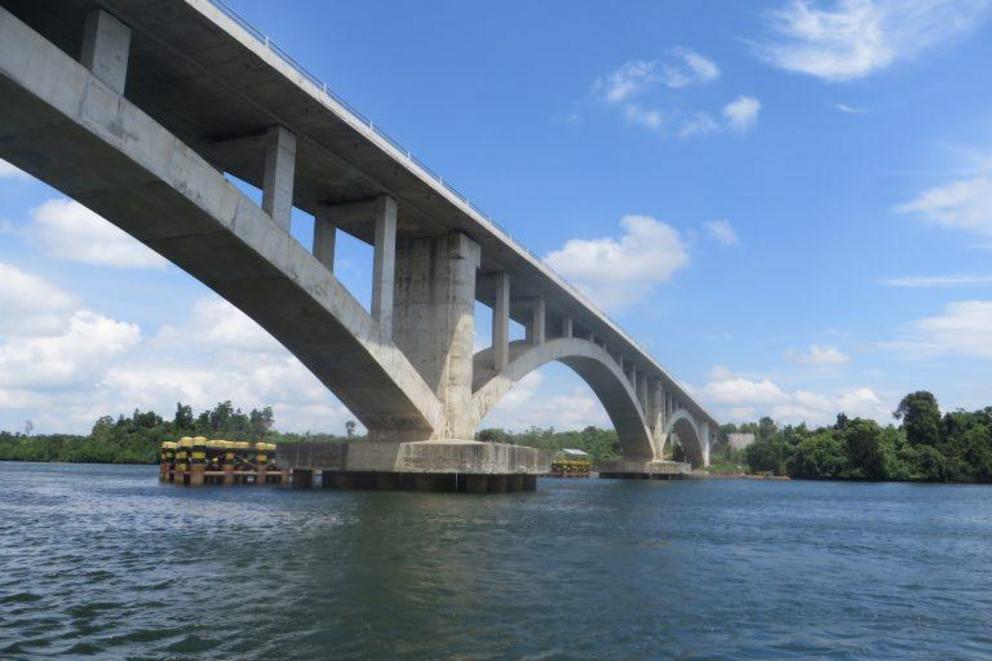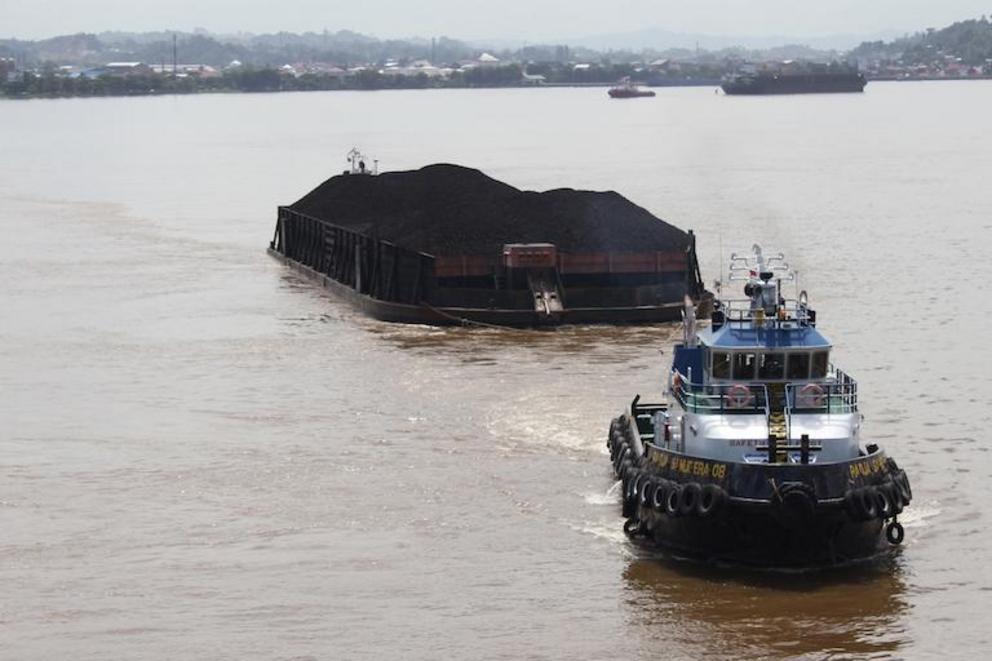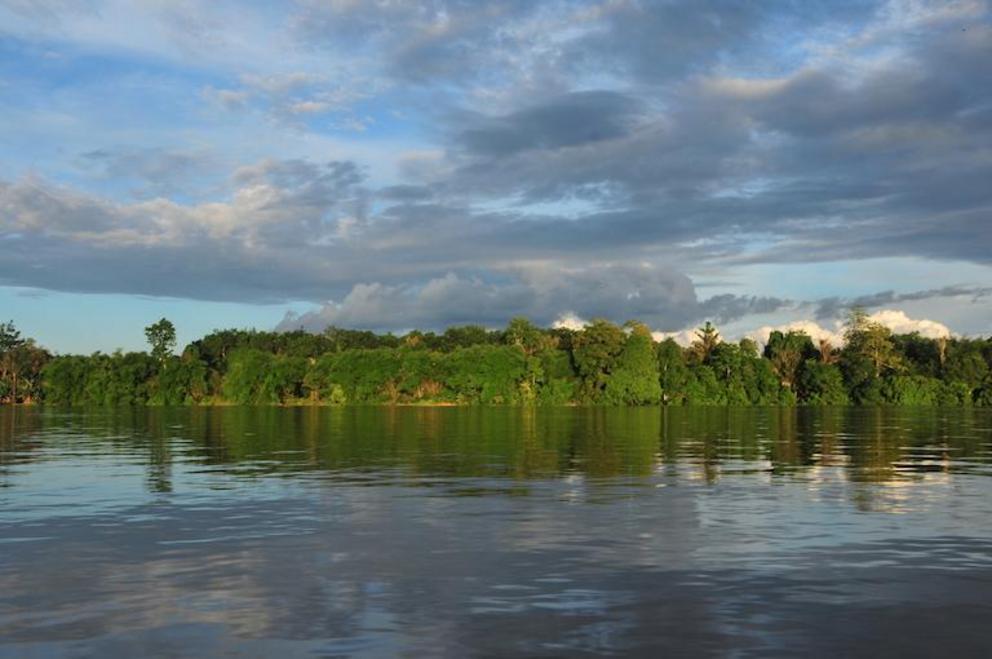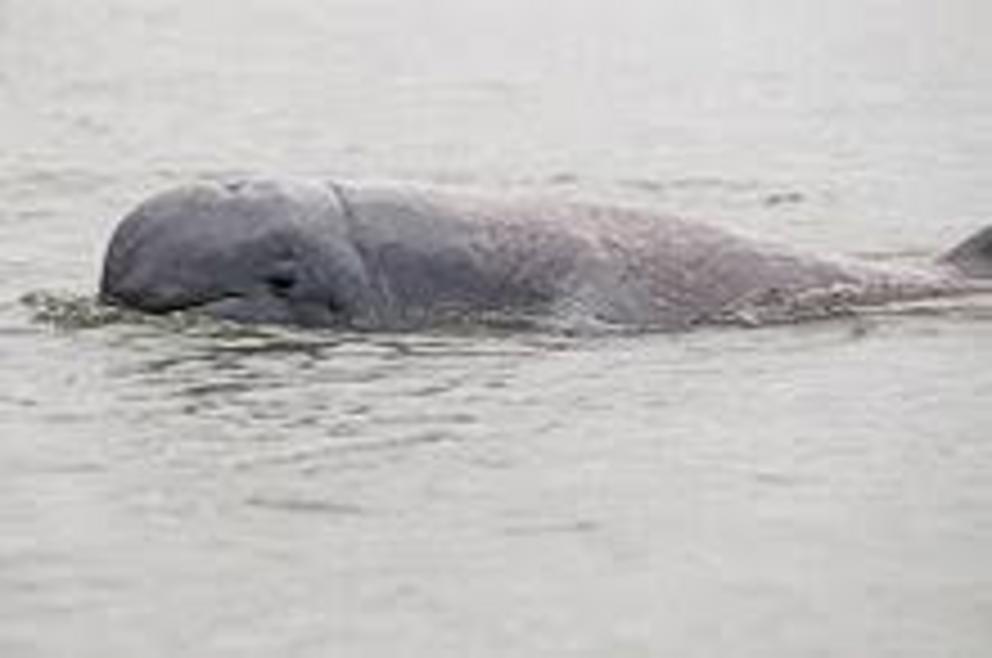Dolphins face growing pressure as development eats into Borneo’s interior
- The ecosystems of East Kalimantan province in Indonesian Borneo face increasing pressure due to mining, logging, industrial agriculture, infrastructure projects, and a plan to establish a new administrative capital city.
- One of the species imperiled by this rapid transformation is the Irrawaddy dolphin.
- Estuarine populations of the species already face severely negative impacts from increasing shipping traffic and coastal development in Balikpapan Bay.
- A critically endangered population of freshwater Irrawaddy dolphins living in the middle reaches of the Mahakam River are also under increasing pressure due to climate change, oil palm cultivation, coal mining and transport.
Amid the steaming swamps adjoining Borneo’s Mahakam River, a fisherman slows his boat to glide gently across the surface of Lake Melintang. He senses something amiss up ahead. A critically endangered freshwater Irrawaddy dolphin (Orcaella brevirostris), locally known as pesut, slithers through the muddy shallows, desperately trying to stay afloat in less than 60 centimeters (2 feet) of water. Earlier, it chased a fish into the shallow lake system and is now marooned. Explosive exhalations from its blowhole mist the air as it refills its lungs.
Danielle Kreb, scientific program manager at the Conservation Foundation for Rare Aquatic Species of Indonesia (YK-RASI), knows this scene well. She suspects climate change is behind the sudden water level fluctuations that catch the dolphins unawares. Local fishermen report such strandings to her to be rescued with the help of her colleagues and enthusiastic community volunteers.
“There is a lot of motivation in the local community to help the dolphins,” she says. “Together, we have halved dolphin mortality by saving stranded dolphins and releasing them from fishermen’s gillnets.”
While organizations like YK-RASI strive to safeguard the dolphins, industrial expansion and extractive industries encroach further inland from the coast in Indonesia’s rapidly developing East Kalimantan province. Few natural habitats are safe from impact, and recent studies suggest the province’s dolphin populations are buckling under the pressure of development.
The Mahakam River meanders 980 kilometers (610 miles) from its headwaters in the heart of Borneo’s lush, old-growth rainforest, where orangutans, rhinoceroses and elephants still co-exist. It traverses East Kalimantan, past oil palm plantations, open-cast mines and timber yards, to a splintered delta into the Makassar Strait on the island’s east coast. It is a lifeline for the communities that farm along its banks and fish its main channel and the shallow lakes of its peat swamps.
The freshwater Irrawaddy dolphins’ main refuge is a 93-km (58-mi) stretch in the middle reaches of the Mahakam, between the districts of Kutai Kartanegara and West Kutai. Although the majority of the species is distributed in coastal waters across southern Asia, the Mahakam dolphins represent one of three riverine populations in the world; the other two are found in the Mekong and the Irrawaddy rivers. Latest population estimates suggest just over 80 dolphins remain in the Mahakam, with five to six calves born each year. Evidence from DNA studies confirms they are genetically distinct from the Irrawaddy dolphins that live along the coast and in Balikpapan Bay, a rapidly urbanizing port city 120 km (75 mi) to the south.
 Young Irrawaddy dolphins can be identified by the fetal folds in their skin. About five calves are born in the Mahakam River each year.
Young Irrawaddy dolphins can be identified by the fetal folds in their skin. About five calves are born in the Mahakam River each year.
Resource extraction and industrial expansion
East Kalimantan supports some of the largest remaining tracts of Indonesia’s tropical forests. Despite intense pressure from human activities, the province’s natural habitats “remain highly diverse and include lowland as well as mountain forest, carst, peat forests, extensive wetlands, mangroves, and coral seas,” says Stanislav Lhota, a primatologist at the Czech University of Life Sciences, who has spent years researching East Kalimantan’s wildlife.
Even though Indonesia has recorded reduced levels of deforestation over the past three years, an alarming uptrend continues in East Kalimantan, where a 43% increase in deforestation was recorded during 2018. Between 2002 and 2019, the province lost 9%, or 1.13 million hectares (2.8 million acres), of its primary rainforest, according to Global Forest Watch.
Lhota attributes this rapid deforestation to the local economy’s focus on agribusiness and resource extraction. Recently, the province rezoned huge areas of disturbed lowland forest for other uses in its latest spatial plan, which is likely to accelerate forest loss and degrade neighboring ecosystems.
Indonesia’s central government is gearing up to make East Kalimantan an economic and industrial powerhouse. Burgeoning extractive industries, such as coal mining, oil palm cultivation and industrial logging, are slated for further expansion along the Kalimantan Economic Corridor, one of six focal areas targeted in the government’s 2011-2025 master plan to stimulate commercial activity through improved transportation infrastructure. Furthermore, the province is home to a flourishing pulp and paper industry, with vast swaths of land earmarked as acacia and eucalyptus plantations.
Finding ways to mitigate the cumulative impacts of simultaneously expanding industries is a major concern. “One problem is that there are now multiple industries that are expanding,” Lhota says. “Each of the industries has its own environmental impact and requires a different set of solutions. All kinds of pressures at the same time mean that none of them will be addressed properly because it is out of the capacity of the government and NGOs.”
 The Pulau Balang bridge under construction in Balikpapan in 2017. Researchers have attributed lower mobility in coastal dolphin populations to noise from coastal construction like this, among other factors.
The Pulau Balang bridge under construction in Balikpapan in 2017. Researchers have attributed lower mobility in coastal dolphin populations to noise from coastal construction like this, among other factors.
Dolphins indicate concerning trends at the coast
Accelerating industrialization in the province is already taking a measurable toll on the Irrawaddy dolphins resident in Balikpapan Bay.
Researchers led by Kreb have conducted long-term surveys of these dolphins and recently published their findings in Frontiers in Marine Science. The study draws on more than 15 years of boat-based transect surveys, interviews with local fishermen, and stranding data from a local marine mammal reporting network.
They found that the Balikpapan Bay dolphins are being hemmed into isolated inland areas of the bay as industrial expansion encroaches on their core habitat. The researchers suggest that the main impediment to mobility is underwater noise caused by shipping traffic accessing the bustling port and oil refinery in the city of Balikpapan.
“Over time, the ships entering Balikpapan Bay got larger, with more ships entering the Bay and preventing the dolphins from distributing themselves across that area,” Kreb says. Like many other species of cetacean, Irrawaddy dolphins are highly sensitive to underwater noise, which stifles their foraging and socializing activities.
According to the study, the dolphins are also under threat from piledriving noise and pollutant runoff from coastal construction, and oil spills from the nearby refinery. In March 2018, oil from a burst pipeline, operated by state-owned oil and gas company Pertamina, devastated an area of 13,000 hectares (32,100 acres) in the bay, smothering mangroves, contaminating seagrass beds and destroying the marine environment. The body of an Irrawaddy dolphin was found washed up on shore, charred and scarred by burning oil.
Kreb adds that the removal of mangroves that act as fish nursery grounds to make way for aquaculture and infrastructure equate to less food for dolphins within the bay. The impacts extend beyond the dolphin population. A recent study in Global Ecology and Conservation found that the coastal forest habitat of the proboscis monkey in Balikpapan Bay shrank by nearly an eighth between 2000 and 2017. The primary driver behind this destruction was a boom in the palm oil processing industry, bringing a glut of bulking stations, refineries and biodiesel plants to the bay.
 Coal barge on the main channel of the Mahakam river. These giant vessels now travel within river dolphin habitat and into narrow tributaries where they affect dolphin migration and feeding patterns.
Coal barge on the main channel of the Mahakam river. These giant vessels now travel within river dolphin habitat and into narrow tributaries where they affect dolphin migration and feeding patterns.
Development engulfs dolphin habitats upstream
Further inland, development in the watershed of the Mahakam River heavily impacts the freshwater Irrawaddy dolphin population. The river is an endpoint for the effects of land clearance, mining waste and increased shipping traffic.
The range waters of the Mahakam Irrawaddy dolphins were initially depleted when swamps and land along tributaries were opened up for oil palm plantations. “Palm oil has meant a serious loss of fish spawning areas,” Kreb says. “When the forest was cleared and plantations established, the water levels were tightly controlled, which led to a loss of important areas for fish. Soon after, dolphins were no longer seen in these areas.”
The heavy-handed use of pesticides and herbicides typically associated with oil palm cultivation leads to further problems with chemical runoff, Kreb says. Other toxic chemicals leak into the river, particularly during high-water periods, and have been reported to cause skin irritation and even pigmentation changes for the dolphins. A 2018 YK-RASI study of water quality in the dolphin’s core habitat found that levels of heavy metal contamination were up to 23 times in excess of minimum standards.
“If the pollutants reaching the river are affecting the dolphins, then they must also be affecting the people that depend on resources from the river,” said Pradarma Rupang of the East Kalimantan chapter of the Mining Advocacy Network (Jatam). “Since coal mining corporations are permitted to use the river for their needs, despite negative effects on local people, livelihoods and biodiversity, the Mahakam River is not healthy anymore.”
As with their estuarine counterparts in Balikpapan Bay, the freshwater dolphins also have to contend with ever-increasing shipping traffic using the river to transport coal from the mines that pepper the region’s interior. Since 2016, giant container barges have passed upstream of Samarinda through core dolphin habitat in the mid-Mahakam to access more and more remote areas as new mines open up. Kreb says ships even pass up and down narrow tributaries, occupying up to two-thirds of the channel width, effectively fragmenting the dolphins’ habitat and acting as a barrier to migration for the freshwater fish on which the mammals depend.
The leviathan coal ships also mean that local fishermen can no longer harvest good catches in stretches of river where they have historically fished.
 The Mahakam river meanders 980 kilometers (610 miles) from its headwaters in the heart of Borneo’s rainforest and traverses East Kalimantan province, past oil palm plantations, opencast mines and timber yards, into the Makassar Strait.
The Mahakam river meanders 980 kilometers (610 miles) from its headwaters in the heart of Borneo’s rainforest and traverses East Kalimantan province, past oil palm plantations, opencast mines and timber yards, into the Makassar Strait.
Predicting future impacts
There is no immediate respite in sight; industry is slated to continue growing for the near future. The estuarine dolphins’ primary habitat in the upper part of Balikpapan Bay, now their only refuge, is directly in the path of expansion. Plans to extend Balikpapan’s industrial parks, which would involve large-scale clearing of coastal forests, and the government’s proposal to move the new Indonesian capital city to the area north of the bay, between the cities of Balikpapan and Samarinda, will transform the region.
A recent study of the potential environmental impacts of the new capital city, published in Land, reports that if urban development extends for 30 km (19 mi) beyond the core of the new capital — which the government predicts will happen by 2045 — it would result in a terrestrial footprint of around 226,000 hectares (558,500 acres). The authors say that the new capital city will intrude on Bukit Soeharto Grand Forest Park and could intensify resource exploitation by displacing palm oil and mining activities to the better-preserved forests of the island’s interior.
According to Jatam, the central government’s vision for pandemic recovery prioritizes the extraction of more natural resources from areas that are already heavily exploited, intensifying pressure on fragile ecosystems. The local government has granted 625 mining permits in Kutai Kartanegara, one of the poorest districts in the province. “The economic gains from mining do not reach local communities, yet their water resources are contaminated and their forests are cleared,” Pradarma said. He adds that mining operations are likely to intensify in the region following the passage of a deregulation law and an amended mining law earlier this year.
Infrastructure impacts from planned and ongoing roads and railways will also be significant. A 2019 Scientific Reports study calculated that such infrastructure projects in Kalimantan will reduce the region’s landscape connectivity from 80% to 55% and “will likely seriously impact the key species and landscape ecological dynamics.” The authors predict that legal and illegal logging, land colonization, illicit mining and wildlife poaching will accelerate as new forest edges are exposed and made accessible.
 Local fishermen and villages work alongside crew from YK-RASI to rescue a stranded adult Irrawaddy river dolphin from Melintang Lake in East Kalimantan during March 2020.
Local fishermen and villages work alongside crew from YK-RASI to rescue a stranded adult Irrawaddy river dolphin from Melintang Lake in East Kalimantan during March 2020.
Community initiative is cause for hope
It is not all doom and gloom, though. In Kutai Kartanegara, there is gathering momentum to protect the dolphins’ core habitat on the Mahakam. Earlier this year, 27 villages and the local government signed an agreement to establish a protected area encompassing a 93-km stretch of core habitat for the dolphins.
Within the 43,000-hectare (106,300-acre) site, forests and swamp vegetation are protected from development, and fishing is controlled by a zonal system in an effort to reduce dolphin entanglements in gillnets and illegal electrofishing. Fishing zones were established in close consultation with fishermen who, together with village river guards, help to monitor and regulate fishing activity.
Local people revere the dolphins, telling tales of how the marine mammals came to be in the river. According to local legend, two naughty children got lost along the riverbanks and ate some enchanted rice they found in an abandoned hut. The rice made them overheat, and upon jumping into the river to cool off, they were transformed into dolphins. The dolphin’s blowhole is a manifestation of the steam arising from their bodies.
“People living along the river have fond memories of swimming with the dolphins when they were children,” Kreb says. “They are very keen on the protected area because they feel it will protect their fish resources.”
Protecting the dolphins’ habitat will help many other species that depend on the river, such as critically endangered Siamese crocodiles and endangered giant freshwater stingrays and turtles. Even wildlife not directly dependent on the river, such as orangutans, proboscis monkeys and nearly 300 bird species, stand to gain from the protected area. “It’s really worthwhile, since a lot of biodiversity depends on the river,” Kreb says.
Activists are pushing for national recognition of the protected area, so that it can be factored into land-use plans and facilitate control of shipping permitted in the dolphins’ core habitat.
If the protection comes through, it might offer some respite for wildlife and local communities. “There’s a lot of challenges of course, but there is hope,” Kreb says.

